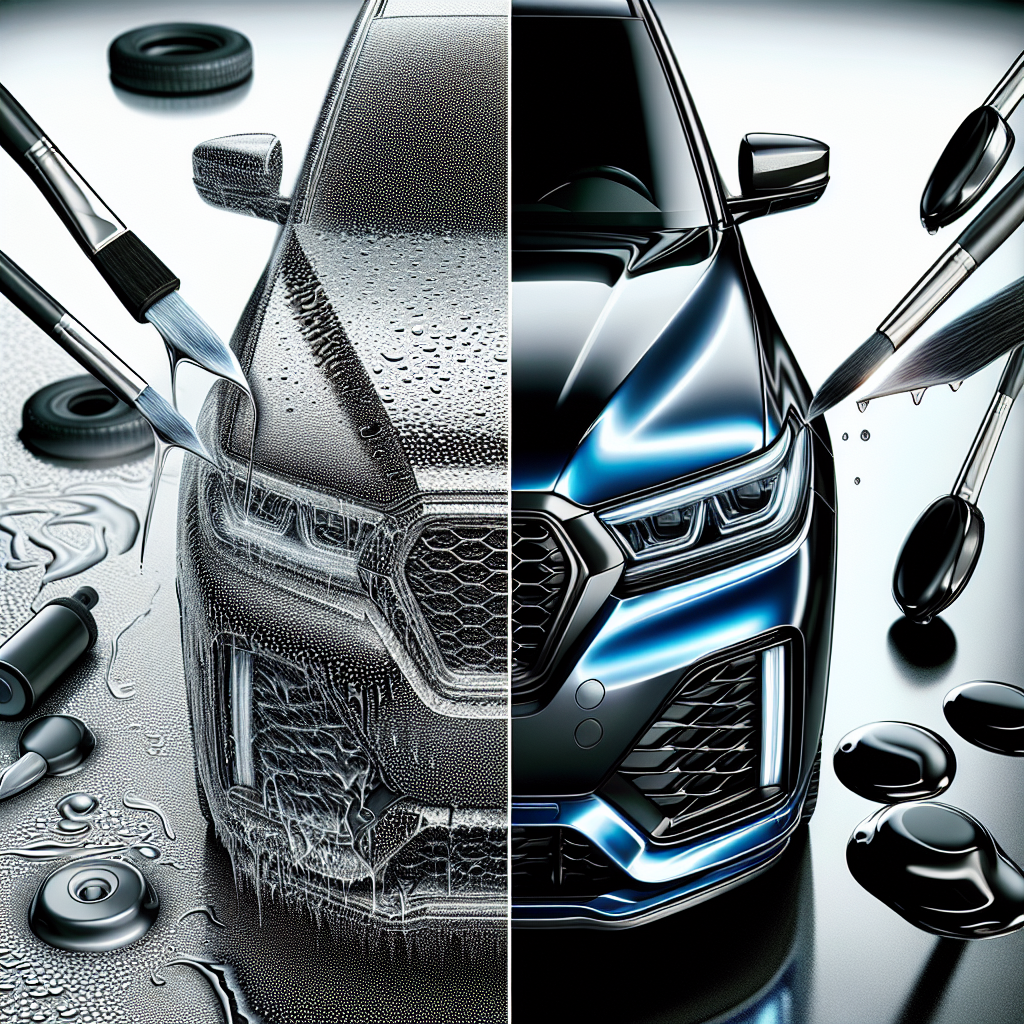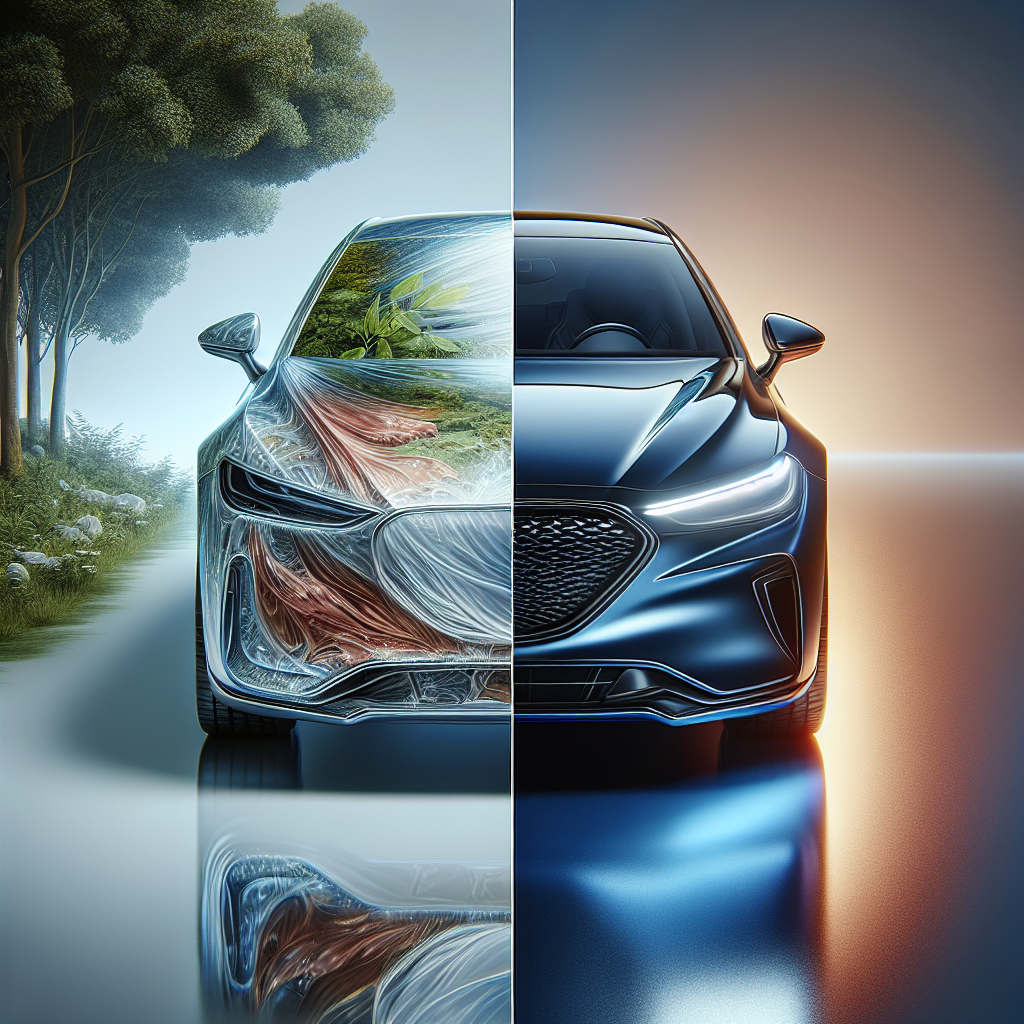When it comes to protecting your car’s paint, two popular options often come up in discussions: Paint Protection Film (PPF) and Ceramic Coating. Both these solutions offer unique benefits that help maintain the aesthetic and functional value of your vehicle. However, understanding the key differences between them can be crucial in making an informed decision.
PPF, also known as a clear bra, is a thermoplastic urethane film applied to the painted surfaces of a car. Originally used in military applications, it has now become a popular choice among car enthusiasts for its exceptional protective qualities. On the other hand, Ceramic Coating is a liquid polymer that chemically bonds with the car’s factory paint, creating a layer of protection that is both durable and glossy.
In this detailed comparison, we will delve into the specific advantages and disadvantages of each option, helping you decide which is best suited for your needs. Whether you are looking to protect your new investment from scratches, UV rays, or environmental contaminants, understanding the nuances of PPF and Ceramic Coating will guide you toward the optimal choice for your vehicle.
Stay tuned as we explore the distinct features, costs, and maintenance requirements of each protective solution. Ready to make your car shine? Call or contact us today to find out how we can help!
Understanding Paint Protection Film (PPF)

Paint Protection Film (PPF) is a transparent, durable material designed to shield your car’s paint from various types of damage. Originally developed for military use to protect helicopter blades from debris, its application has now expanded into the automotive industry, where it offers a robust protective barrier for vehicles.
PPF is crafted from a thermoplastic urethane material that is both flexible and resilient. This unique composition allows it to absorb impacts from small rocks, road debris, and other environmental hazards, effectively preventing scratches, chips, and other forms of paint damage. One of the standout characteristics of PPF is its self-healing properties; minor scratches and swirl marks can disappear with the application of heat, such as from the sun or warm water.
Another significant benefit of PPF is its clarity. When properly applied, it is virtually invisible, maintaining the original look and color of your vehicle’s paint. This makes it an ideal choice for car owners who want to preserve the aesthetic appeal of their vehicles while adding a layer of protection. Additionally, PPF offers UV protection, preventing the paint from fading over time due to prolonged sun exposure.
PPF is usually applied by professionals using a wet application method, which involves carefully adhering the film to the car’s surface with a special solution. This process ensures a seamless fit and long-lasting adhesion, making sure the film remains effective for years. While the initial investment in PPF can be higher than other protective options, its long-term benefits in preserving your car’s paint are well worth the cost.
Exploring the Benefits of Ceramic Coating

Ceramic Coating, often referred to as nano-ceramic coating, is a liquid polymer applied to a vehicle’s exterior. Once cured, it forms a chemical bond with the factory paint, creating a hydrophobic layer that offers superior protection. This layer not only enhances the car’s appearance by giving it a glossy finish but also provides several practical benefits.
One of the primary advantages of ceramic coating is its ability to repel water and contaminants. The hydrophobic properties mean that water beads up and rolls off the surface, taking dirt and grime with it. This makes washing your car easier and less frequent, as the coating helps keep your vehicle cleaner for longer periods.
Ceramic coatings are also highly resistant to UV rays, which can cause paint to oxidize and fade over time. By blocking these harmful rays, the coating helps maintain the car’s original color and shine. Additionally, ceramic coatings offer some level of protection against chemical stains and etching from acidic contaminants like bird droppings, tree sap, and bug splatters, which can be challenging to remove and damaging to paintwork.
Another notable benefit is the enhanced durability of ceramic coatings. Unlike traditional waxes and sealants, which wear off after a few months, a quality ceramic coating can last for years with proper maintenance. This long-lasting protection means less frequent applications and better overall value for car owners.
It’s important to note that while ceramic coatings provide excellent protection, they are not invincible. They do not prevent all types of scratches or rock chips but do add a significant layer of defense compared to untreated paint. When professionally applied, ceramic coatings can greatly enhance the aesthetic and longevity of a vehicle’s finish, making them a popular choice among car enthusiasts and everyday drivers alike.
Comparing Durability and Longevity
When considering PPF vs. Ceramic Coating, understanding the differences in durability and longevity is crucial in making an informed decision. Both options are designed to protect your vehicle’s paint, but they do so in distinct ways and offer varying levels of durability over time.
Paint Protection Film (PPF), also known as clear bra, is a thermoplastic urethane film applied to the exterior surfaces of the car. PPF is renowned for its excellent durability. It provides robust protection against physical damage such as rock chips, minor scratches, and abrasions. The film is self-healing, meaning that minor scratches and swirls can disappear when exposed to heat. This characteristic ensures that PPF maintains a pristine appearance for years. Typically, a high-quality PPF can last anywhere from 5 to 10 years, depending on the conditions it is exposed to and how well it is maintained.
On the other hand, ceramic coating offers a different kind of durability. While it does not provide the same level of protection against physical impacts as PPF, it excels in protecting against chemical damage and environmental contaminants. Ceramic coatings form a hard, protective layer that can last between 2 to 5 years, with some high-end coatings potentially lasting up to 7 years. The coating is highly resistant to UV rays, preventing paint oxidation and fading, and its hydrophobic properties make it easier to clean and maintain the vehicle’s shine.
In summary, if you are looking for maximum protection against physical damage and are willing to invest in a longer-lasting solution, PPF is the superior choice. However, if you prioritize ease of maintenance, protection against environmental contaminants, and a high-gloss finish, ceramic coating is an excellent option. Both PPF and ceramic coatings have their strengths and can even be used together for comprehensive protection and enhanced durability.
Cost and Maintenance Considerations

When evaluating PPF vs. Ceramic Coating, cost and maintenance considerations are essential factors that can influence your decision. Both options come with different price points and upkeep requirements, which can affect your overall experience and satisfaction.
Paint Protection Film (PPF) is generally the more expensive option upfront. The cost can vary significantly based on the quality of the film and the extent of coverage. For instance, a full-car PPF application can range from several hundred to several thousand dollars. The installation process is intricate and requires professional expertise to ensure a seamless application, which contributes to the higher cost. However, the long-term benefits of PPF, such as its self-healing properties and superior protection against physical damage, can justify the initial investment.
Maintenance for PPF is relatively straightforward. Regular washing and occasional use of a PPF-specific sealant can keep the film in top condition. It’s crucial to avoid abrasive cleaners and automated car washes with harsh brushes, as these can damage the film. With proper care, PPF can last up to a decade, providing excellent value over time.
Ceramic coating, while generally less costly than PPF, still represents a significant investment. The price for a professional ceramic coating application can range from a few hundred to over a thousand dollars, depending on the product’s quality and the detailer’s expertise. Ceramic coatings offer excellent durability and a high-gloss finish, but they do not provide the same level of protection against physical impacts as PPF.
In terms of maintenance, ceramic coatings are relatively low-maintenance compared to traditional waxes. The hydrophobic properties of the coating make it easier to clean the vehicle, as dirt and grime are less likely to adhere to the surface. Regular washing with a pH-neutral soap and periodic decontamination treatments are recommended to maintain the coating’s effectiveness. Over time, you may need to reapply the ceramic coating to maintain optimal protection and shine.
Ultimately, the decision between PPF and ceramic coating will depend on your budget, the level of protection you desire, and your willingness to invest in long-term maintenance. Both options offer unique benefits that can enhance your vehicle’s appearance and preserve its value.
Choosing the Right Protection for Your Car

Deciding between PPF vs. Ceramic Coating ultimately comes down to your specific needs, preferences, and budget. Both options offer exceptional benefits, but understanding what each one brings to the table can help you make an informed decision.
If your primary concern is protecting your vehicle from physical damage such as rock chips, scratches, and abrasions, Paint Protection Film (PPF) might be the better choice. PPF provides a robust barrier against these types of damage, thanks to its self-healing properties and thicker composition. This makes it an ideal option for those who frequently drive on highways or in areas with harsh environmental conditions.
On the other hand, if you are looking for a solution that enhances your car’s appearance with a high-gloss finish while offering substantial protection against UV rays, chemical stains, and minor scratches, then ceramic coating could be the way to go. Ceramic coatings are excellent for car enthusiasts who take pride in maintaining a pristine, showroom-quality finish. They also make regular cleaning easier due to their hydrophobic properties, which repel water and dirt.
For some car owners, a combination of both might be the optimal solution. Applying PPF to high-impact areas like the hood, fenders, and front bumper, while using ceramic coating on the rest of the vehicle, can offer the best of both worlds. This hybrid approach maximizes protection and aesthetic appeal, ensuring your car remains in top condition for years to come.
Ultimately, the right choice depends on your specific needs and how you use your vehicle. Consulting with a professional detailing service can provide valuable insights tailored to your situation. At Unique’s Auto Care, we specialize in both PPF and ceramic coating applications. Our expert team is here to help you choose the perfect protection for your car, ensuring it stays protected and looks stunning.
Ready to give your car the ultimate protection it deserves? Call or contact us today to schedule a consultation and find out which option is best for you.
